|

by J. Edward Carper
February 28, 2013
from JabbingJupiter Website
Proposed Resulting in
The July 19, 2009 “Wesley Mark”
|
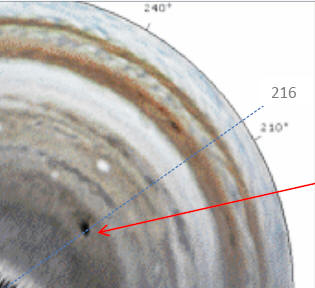 |
July 19, 2009
Mark spotted and first imaged by Anthony Wesley at 216
(II), -57. (305:III, -57)
The lower left of the frame is the south pole of
Jupiter. |
|
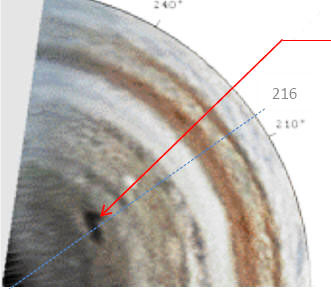 |
July 29, 2009 (approx. 10
days later)
The core of the mark is still at 216 (II), -57.
Black debris has spread east from there. |
|
Theo Ramakers writes,
"Here is an updated
animation containing the images of a large number of
dedicated Jupiter imagers, members of the ALPO
Jupiter listserve. Hans Joerg Mettig from Jupos.com
in Germany converted the submitted images to a polar
projection, and I put them together in an animation.
Notice the rather that just spreading out, the
original impact site seems to keep pouring out black
stuff that then drifts away.”
Theo Ramakers [with the
Association of Lunar and Planetary Observers]
http://www.skyandtelescope.com/news/53952917.html
|
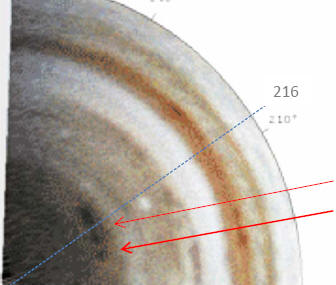 |
August 9,
2009 (3 weeks after July 19)
Mark core/origin still at 216 (II), -57
Black debris has spread further east at a rate of about
15 km per hr., the general rate of easterly winds at
this latitude in the SPR (South Polar Region). |
|
Individual frames, as
included in an animation by Hans Joerg Mettig and Theo
Ramakers.
The full animation can also
be found at:
http://www.planetary.org/blogs/emily-lakdawalla/2009/2049.html
|
|
(A) Asteroid impact scenario |
|
|
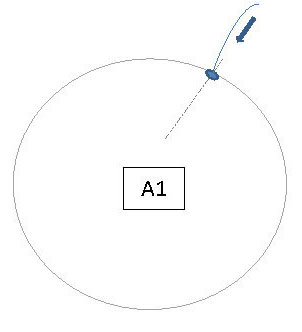 |
|
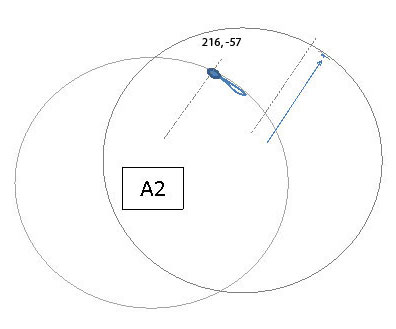 |
Debris, broken and displaced
by the winds.
In the conventional theory
this is what should have occurred because the proposed
“asteroid” could not have penetrated deep enough to
cause the debris to appear to “hold in place”.
Also note that the asteroid
theory goes against other conventional theory that
suggests only comets should be rarely impacting Jupiter. |
|
Permission is given to print
and distribute this article only on “no cost to the
reader” basis. JEC
|
|
(B) Internal event scenario |
|
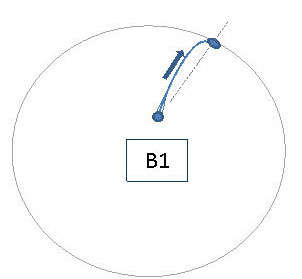 |
Silica
source inside Jupiter (near center). Abundant silica was
found in the debris. |
|
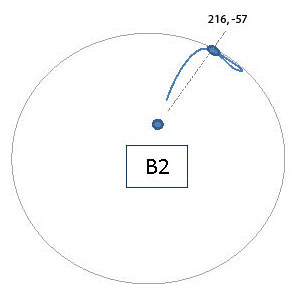 |
The evidence suggests a deep
internal event violently thrust liquidated material from
near the center of Jupiter up to the surface.
A sudden and extreme
pressure change near the center could have caused this. |
|
In the above diagrams, ‘A1’,
then 3 weeks later, ‘A2’, resulting from an initial
“asteroid impact”, is the conventional explanation,
whereas ‘B1’ then ‘B2’ 3 weeks later, is the proposed
logical explanation.
The dashed line in all
diagrams goes through the surface of Jupiter at 216(II)
longitude, 57 south latitude, the original site of the
“Wesley mark”.
Scenario ‘A’ (conventional theory) is not plausible, as
any asteroid debris would have been carried east in its
totality and broken up further and further east over
time as shown to the right.
After just one week all
debris should have generally been displaced at least
6000 km east and should have hardly been visible at that
time. |
NOTE 1
What the information in the above article
suggests is that there has been an extraordinary event very deep
inside Jupiter occurring near what used to be its "rocky core".
This event has been
theorized in my book
to have been plausibly produced by a trillion Kelvin heat spark from
one of the fuel pellets that NASA/D.O.E. inserted into Jupiter
within the protected
GAEP probe in December of 1995 (the pellets
took 13.5+ years to drift down that far).
Such a heat spark could have come from a
fission reaction from the plutonium-238/239 within this fuel pellet
(called an
LWRHU).
Even though the amount of fissionable material is small in one of
these LWRHU's, it would have survived the journey to reach a point
of around 30 million bars pressure (near the core of Jupiter) at
which point only a very small mass of fissionable material is
necessary to reach the "supercritical point" for fission to occur,
and the fuel in the pellet IS a fissionable material, that is,
"capable of producing a sustained FISSION reaction".
This method is very similar to the way a
hydrogen bomb works on Earth, yet deep inside Jupiter the "charged
and angled implosion mechanism" is taken care of naturally by the
very even, extreme, and homogenous pressure applied to all sides of
the LWRHU pellet to initiate FISSION and then FUSION thereafter in
the heavy Jupiter hydrogen.
How can the plutonium survive to this depth inside Jupiter?
The
'equation of state' for its protective heat shield made of carbon
allows it, since as more pressure is applied to the carbon, it takes
more and more heat to melt it, so it actually stays a solid until
its contents fission.
Once a fission spark of this incredible temperature was made
possible, this was immediately hot enough to cause a NUCLEAR FUSION
CHAIN REACTION that produced an enormous explosion (the dense
hydrogen outside the core here would encourage this, a P-P fusion
reaction).
This initial disturbance tried to find pressure equilibrium by
shifting towards the surface of Jupiter.
In its wake it left a pressure void that
soon reached and affected the rocky center of Jupiter causing it to
violently liquidate sending up small portions of Jupiter's center
all of the way to its surface! Incredibly, this is what we may have
seen on July 19, 2009, portions of the silica center of Jupiter
being expelled (abundant silica was detected in the signature of the
Wesley mark).
To clarify, imagine the core of Jupiter
under 10's of millions of bars of pressure suddenly being exposed to
pressures much, much lower. That is a recipe for violent expulsion.
Similar action happens when magma deep under the Earth's crust
becomes too hot and thrusts upward, call a "thermal convection
shaft".
Also note that no halo was spotted for the supposed "impact" of an
asteroid.
If such an asteroid impact had occurred
to cause the Wesley mark, there would have been a compression mark
called a "halo". Additionally, all asteroids were have to been
cleared out by Jupiter millions of years ago, yet we are to believe
that not only was one still present but that it had the gall to
impact Jupiter!
This fusion reaction could still be modestly burning away near the
center of Jupiter, for in 2010 and 2012 we saw yet more evidence of
Jupiter's center being under duress; two massive and antipodal
electrical discharges imaged at the surface of Jupiter in 2010
followed in 2012 by yet the most massive of the three.
NASA has recently released an article
("Turmoil From Below...") highlighting the "global heat changes"
occurring within Jupiter in the last few years since 2009.
All of the evidence points to an internal event of great magnitude
affecting Jupiter, and continuing to affect it.
See "The
Philosopher's Stone for the Transformation of Jupiter - Project
Lucifer" for more information on this theory.
Note 2
With the Wesley mark there is
clear evidence of a sustained fusion reaction deep inside Jupiter
(it may or may not still be on-going but it lasted for a significant
amount of time).
The mark we saw at the surface was not
fusion actually happening at the surface (that stayed deep), but the
mark was the result of liquidation of the high pressure center of
Jupiter after the fusion reaction had changed the pressure dynamics
there (the extreme pressure change propelled material upward for
three weeks).
This is the only way silica could be
found in the signature at the surface...
Somewhat like a Jupiter volcano caused
by an extreme event below.
|







